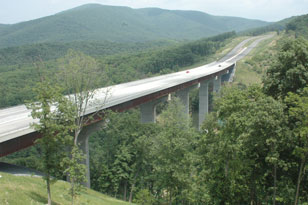 A continuous I-girder structure whose six spans of 210, 275, 275, 275, 275 and 210 feet used nearly 2.4 million pounds of HPS steel to cross a deep valley outside Moorefield on giant hollow piers rising as high as 275 feet above the valley floor, the $20.1 million Clifford Hollow Bridge was built by Dick Corporation of Pittsburgh, Pennsylvania.
A continuous I-girder structure whose six spans of 210, 275, 275, 275, 275 and 210 feet used nearly 2.4 million pounds of HPS steel to cross a deep valley outside Moorefield on giant hollow piers rising as high as 275 feet above the valley floor, the $20.1 million Clifford Hollow Bridge was built by Dick Corporation of Pittsburgh, Pennsylvania.
More than two miles of four-lane highway on either side of the bridge, requiring 6.6 million cubic yards of excavation, were built for over $50 million by a Hermitage, Tennessee firm now known as M&S Infrastructure as part of a 20-mile, $266 million segment of Corridor H between Baker and Wardensville, where the byproducts of constant poultry transport often added a treacherously slick surface to the curves of existing WV 55.
One of the highway approaches includes a mountaintop paved parking lot that provides an opportunity for eastbound motorists to get a scenic overlook of Clifford Hollow, where hawks circle through the blue haze of the heavily forested, previously untraveled location.
During construction, the area atop the mountain was the assembly site for the mammoth bridge. The giant metal skeleton grew—sometimes at the rate of 20 feet or more every hour—and slowly slid across the ground until it was launched toward the next mountaintop. The technique protected the existing environment by assembling beams, bolts and cross-bracing in sections up to 275 feet in length, then “launching in place.”
Four hydraulic cylinders powered each bridge section across some 400 feet of track rollers until it cantilevered out over the valley. A kingpost frame in the assembly area provided a cable-stay to the end of the bridge section and “emergency brakes”—chains at the abutment—allowed it to back up the track, if necessary. The cantilevered sections were fastened down with temporary cables to guard against movement by strong wind in the valley. As they reached the piers, the sections rested on temporary rollers that were eventually removed as the completed bridge was jacked up, then down onto permanent seats.